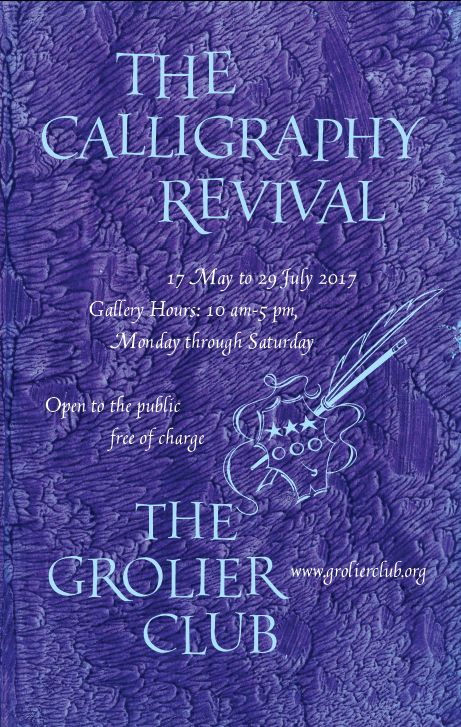May 17 - July 29, 2017
The Calligraphy Revival 1906–2016: An Exhibition of the Art of Beautiful Writing
Curated by Jerry Kelly
The word calligraphy comes from the Greek for “beautiful” (calli) “writing”

(graphy). It is an art with a long and noble history, going back many centuries and spanning cultures. Exhibitions and collections of Asian art, Persian art, or even Medieval Western art have always included examples of beautiful writing, yet modern Western calligraphy has not been recognized as an art form. This exhibition, The Calligraphy Revival 1906–2016, on view at the Grolier Club from May 17 through July 29, 2017, aims to correct that oversight. Curator Jerry Kelly, an award-winning book designer, type designer, typographer, and calligrapher, is presenting major examples of calligraphic art by over 80 Western artists spanning the years 1906-2016, demonstrating how alive – even thriving – the art is in the West in the computer age.
CALLIGRAPHY AS A FINE ART
“Surely the alphabet is one of the major accomplishments of mankind. The expression of this utilitarian creation can rise to the level of fine art, just as architecture, photography, and other ‘useful’ expressions of the human mind are appreciated as art. It is an unfortunate distinction of beautiful writing that, while these other arts have been exhibited at major museums throughout the world, calligraphy remains underappreciated. We hope this selection will help to expose more people to the beauty and expression of the handwritten letter arts,” notes Mr. Kelly.
THE CALLIGRAPHY REVIVAL
The art of calligraphy has enjoyed a remarkable revival over the past century or more, spurred on in good part by the teaching of the British scribe Edward Johnston (1872–1944). Johnston’s students, such as Graily Hewitt and Irene Wellington, spread his principles through succeeding generations of calligraphers. His manual, Writing & Illuminating, & Lettering, originally published in 1906, has been the calligrapher’s bible ever since.
Another important influence from around the same time is Rudolf Koch of Germany, who also trained a remarkable group of students, as well as publishing several instruction books. Johnston’s manual was issued in the same year that a piece of Koch’s calligraphy was first reproduced, in Künstlerischer Schrift in Vienna, 1906. That year is seen as the starting point of the modern revival of calligraphy.
Most of the artists in this exhibition can trace their roots back to these two seminal calligraphers. For example, Alfred Fairbank was a student of Hewitt. Karlgeorg Hoefer studied at the Technische Lehranstalt in Offenbach, Germany, where Koch had established the calligraphy program; and Hermann Zapf was self-taught from the manuals of both Johnston and Koch. All are represented by work in the show.
THE SCOPE OF THE EXHIBITION
The show is representative of the variety of calligraphic work done over the past 110 years, a most fruitful period in the history of the art. In addition to the best-known artists of the period, some not-so-well-known scribes have been included in the mix. Only one work per calligrapher is presented, no matter how important or prolific the artist may be.
The selections were made in consultation with several calligraphers: Christopher Calderhead (editor, Letter Arts Review, Charlottesville, NC), Anna Pinto (board member, The Society of Scribes, New York, NY), Rob Saunders (founder and curator, Letterform Archive, San Francisco, CA), and Julian Waters (award-winning lettering artist, Washington, DC). In some instances, the scribes themselves were asked to select a piece for inclusion.
Examples of the letter arts focus primarily on works in the Latin alphabet, with two exceptions: a few lines in Hebrew culminating in the word “Shalom” in Ismar David’s silkscreen print (the rest of the lettering on that broadside is in the Latin alphabet), and some Arabic, Japanese, and Tibetan scripts are incorporated into the artwork by Brody Neuenschwander of Belgium. In addition to original, one of a kind works, there are a few limited-edition prints by silkscreen, letterpress from handcut blocks, or even high-quality offset on special papers, as well as three dimensional objects: letters hand-cut on slate, hand-glazed on ceramics, hand-cut on wood, and even etched on glass.
Lenders to the exhibition include the Harrison Collection at the San Francisco Public Library, one of the finest repositories of modern calligraphy; Letterform Archive; and various artists from around the world.
ABOUT THE CURATOR
Jerry Kelly’s book design work has been selected over thirty times for inclusion in the AIGA “Fifty Best Designed Books of the Year” show, and in 2015 he was presented with the Goudy Prize from the Rochester Institute of Technology. He has written several books and numerous articles on the subjects of calligraphy, book design, and typography.
CATALOGUE: Accompanying the exhibition is a hardcover catalogue fully illustrated in color. It is available for purchase at the Grolier Club and from Oak Knoll Books.
PUBLIC EVENTS:
Free Lunchtime Exhibition Tours: June 7 and 21, 1:00 pm - 2:00 pm. Curator Jerry Kelly will lead free public tours of his exhibition, “The Calligraphy Revival 1906–2016”. No reservations necessary.
Panel Discussion: May 18, 6:00 PM - 7:30 pm. “Calligraphy as a Fine Art”. Speakers: Christopher Calderhead, Editor, Letter Arts Review, Moderator; Femke Speelberg, Associate Curator of Prints & Drawings, Metropolitan Museum of Art; Rob Saunders, Founder & Curator, Letterform Archive; Michael Sull, Certified Master Penman. Free, but seating is limited. Please contact Maev Brennan at
[email protected] for a reservation.